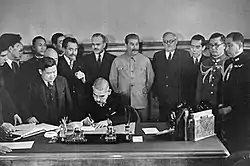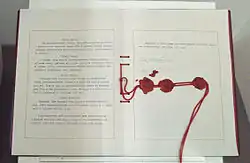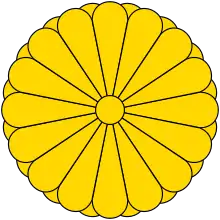Soviet–Japanese Neutrality Pact
The Soviet–Japanese Neutrality Pact (日ソ中立条約, Nisso Chūritsu Jōyaku), also known as the Japanese–Soviet Non-aggression Pact (日ソ不可侵条約, Nisso Fukashin Jōyaku), was a neutrality pact (non-aggression pact) between the Soviet Union and Japan signed on April 13, 1941, two years after the conclusion of the Soviet-Japanese Border War. The agreement meant that for most of World War II, the two nations fought against each other's allies but not against each other. In 1945, late in the war, the Soviets scrapped the pact and joined the Allied campaign against Japan.
 Japanese Foreign Minister Matsuoka signing the pact | |
| Type | bilateral treaty |
|---|---|
| Signed | 13 April 1941 |
| Location | Moscow, Russian SFSR, USSR |
| Original signatories | |
| Ratifiers | |

Background and history
After the Fall of France and the subsequent expansion of the Axis Powers, the Soviet Union wished to mend its diplomatic relations in the Far East in order to safeguard its eastern border and concentrate on the European theatre of war. On the other hand, Japan, bogged down in a seemingly interminable war with China and with diplomatic relations with the United States rapidly deteriorating, sought an accommodation with the Soviet Union that would improve its international standing and secure the northern frontier of Manchukuo against possible Soviet invasion.
Soviet ruler Stalin was initially unaware of Hitler's briefing to his generals that an attack on the Soviet Union by the European Axis Powers would enable Japan to challenge the United States overtly. This briefing was based on the belief that if such an attack occurred, the Soviet Union would be too preoccupied with fighting Germany, thus making Japan feel less threatened by any possible Soviet invasion of Manchukuo, allowing Japan to have enough provisions and capabilities to start a war with the United States. This treaty would allow both Japan and the Soviet Union to avoid fighting on multiple fronts. Stalin believed that his "problems can be solved in a natural way if the Soviets and the Japanese cooperate". After concluding the nonaggression treaty, Stalin, in an unprecedented gesture, saw Foreign Minister Yosuke Matsuoka off at the train station. This was symbolic of the importance Stalin attached to the treaty; it also provided him with the occasion – in the presence of the entire diplomatic corps – to invite negotiations with Germany while flaunting his increased bargaining power.[1]
The treaty[2] was signed in Moscow on April 13, 1941, by Foreign Minister Yosuke Matsuoka and Ambassador Yoshitsugu Tatekawa for Japan and Foreign Minister Vyacheslav Molotov for the Soviet Union.
On the same day, the same people also signed a declaration regarding Mongolia and Manchukuo.[3] The Soviet Union pledged to respect the territorial integrity and inviolability of Manchukuo, while Japan did the same for Mongolia.
Later in 1941, Japan, as a signatory of the Tripartite Pact, considered denouncing the Soviet–Japanese Neutrality Pact, especially after Germany invaded the Soviet Union (Operation Barbarossa), but made the crucial decision to keep it and to expand southwards invading the European colonies in Southeast Asia instead. This had a direct bearing on the Battle of Moscow, where the absence of a Japanese threat enabled the Soviets to move large forces from Siberia and send them to the front lines against the Germans.
It is possible that had Stalingrad fallen, Japan would have invaded Siberia. General Tomoyuki Yamashita, known for his achievements in the Battle of Singapore, was sent to Manchuria in July 1942, and he may have been tasked with organizing the troops for the invasion.[4]
At the Yalta Conference in February 1945, Stalin agreed to enter the war against Japan in exchange for American and British recognition of certain Soviet territorial claims in Asia. The deadline for this promised action was three months after the end of World War II in Europe. The deal was kept secret.
On April 5, 1945, the Soviet Union denounced the pact with Japan, informing the Japanese government that "in accordance with Article Three of the above mentioned pact, which envisaged the right of denunciation one year before the lapse of the five-year period of operation of the pact, the Soviet Government hereby makes known to the Government of Japan its wish to denounce the pact of April 13, 1941."[5] The wording of the denunciation suggested that the Soviet Union wished to see the treaty go out of effect immediately, and Time magazine reported that the Soviet Foreign Commissar's tone indicated that the Soviet Union might go to war with Japan soon.[6] However, the text of the treaty stated that the pact remained in force until one year after declaration of denunciation by one party, that is April 1946. When pressed by the Japanese Ambassador Naotake Sato, Molotov assured him that the treaty would remain in force until April 1946.[7]
On May 8/9, 1945 (the date depending on the time zone), Nazi Germany surrendered, ending the war in Europe and starting the secret three-month countdown for Soviet commencement of hostilities against Japan. On August 9, 1945, just after midnight Manchurian time, the Soviets invaded Manchuria. The declaration of war against Japan followed nearly six hours later. Because of the time zone difference of 7 hours,[8] the declaration of war could be still dated August 8, 1945, being presented to the Japanese ambassador in Moscow at 11 p.m. Moscow time.[9] By the time of the Soviet invasion, Japanese forces on the Asian mainland were ill prepared to resist, and they were overrun relatively quickly. In this last campaign of the war, Soviet territorial gains on the continent were Manchukuo, Mengjiang (Inner Mongolia) and northern Korea.
Treaty
PACT OF NEUTRALITY BETWEEN UNION OF SOVIET SOCIALIST REPUBLICS AND JAPAN[2]
The Presidium of the Supreme Soviet of the Union of Soviet Socialist Republics and His Majesty the Emperor of Japan, guided by a desire to strengthen peaceful and friendly relations between the two countries, have decided to conclude a pact on neutrality, for which purpose they have appointed as their Representatives:
- The Presidum of the Supreme Soviet of the Union of Soviet Socialist Republics -
- Vyacheslav Mikhailovich Molotov, Chairman of the Council of People's Commissars and People's Commissar of Foreign Affairs of the Union of Soviet Socialist Republics;
- His Majesty the Emperor of Japan -
- Yosuke Matsuoka, Minister of Foreign Affairs, Jusanmin, Cavalier of the Order of the Sacred Treasure of the First Class, and
- Yoshitsugu Tatekawa, Ambassador Extraordinary and Plenipotentiary to the Union of Soviet Socialist Republics, Lieutenant General, Jusanmin, Cavalier of the Order of the Rising Sun of the First Class and the Order of the Golden Kite of the Fourth Class,
who, after an exchange of their credentials, which were found in due and proper form, have agreed on the following:
- Article one: Both Contracting Parties undertake to maintain peaceful and friendly relations between them and mutually respect the territorial integrity and inviolability of the other Contracting Party.
- Article two: Should one of the Contracting Parties become the object of hostilities on the part of one or several third powers, the other Contracting Party will observe neutrality throughout the duration of the conflict.
- Article three: The present Pact comes into force from the day of its ratification by both Contracting Parties and remains valid for five years. In case neither of the Contracting Parties denounces the Pact one year before the expiration of the term, it will be considered automatically prolonged for the next five years.
- Article four: The present Pact is subject to ratification as soon as possible. The instruments of ratification shall be exchanged in Tokyo, also as soon as possible.
In confirmation whereof the above-named Representatives have signed the present Pact in two copies, drawn up in the Russian and Japanese languages, and affixed thereto their seals.
Done in Moscow on April 13, 1941, which corresponds to the 13th day of the fourth month of the 16th year of Showa.
V. Molotov;
Yosuke Matsuoka;
Yoshitsugu Tatekawa
Declaration
DECLARATION[3]
In conformity with the spirit of the Pact on neutrality concluded on April 13, 1941, between the U.S.S.R. and Japan, the Government of the U.S.S.R. and the Government of Japan, in the interest of insuring peaceful and friendly relations between the two countries, solemnly declare that the U.S.S.R. pledges to respect the territorial integrity and inviolability of Manchoukuo and Japan pledges to respect the territorial integrity and inviolability of the Mongolian People's Republic.
Moscow, April 13, 1941
On behalf of the Government of the U.S.S.R.
V. MOLOTOVOn behalf of the Government of Japan
YOSUKE MATSUOKA
YOSHITSUGU TATEKAWA
Denunciation
Soviet Denunciation of the Pact with Japan[5]
The American Ambassador at Moscow transmitted to the Secretary of State, by a telegram dated April 5, 1945, the following statement, as received from the press section of the Foreign Office, regarding Soviet denunciation of the U.S.S.R.-Japanese neutrality pact:
" Today at 3 p.m. People's Commissar for Foreign Affairs of the USSR Mr. V. M. Molotov, received the Japanese Ambassador, Mr. N. Sato, and made the following statement to him in the name of the Soviet Government:
'The neutrality pact between the Soviet Union and Japan was concluded on April 13, 1941, that is, before the attack of Germany on the USSR and before the outbreak of war between Japan on the one hand and England and the United States on the other. Since that time the situation has been basically altered. Germany has attacked the USSR, and Japan, ally of Germany, is aiding the latter in its war against the USSR. Furthermore Japan is waging a war with the USA and England, which are allies of the Soviet Union.
In these circumstances the neutrality pact between Japan and the USSR has lost its sense, and the prolongation of that pact has become impossible.
On the strength of the above and in accordance with Article Three of the above mentioned pact, which envisaged the right of denunciation one year before the lapse of the five-year period of operation of the pact, the Soviet Government hereby makes know [sic] to the Government of Japan its wish to denounce the pact of April 13, 1941.'
The Japanese Ambassador Mr. N. Sato, promised to inform the Japanese Government of the statement of the Soviet Government."
Declaration of War
Soviet Declaration of War on Japan[10]
London, Aug., 8, 1945 - Foreign Commissar Molotov's (sic) announcement of the declaration of war, as broadcast by Moscow, follows:
"On Aug. 8, People's Commissar for Foreign Affairs of the U.S.S.R. Molotov received the Japanese Ambassador, Mr. Sato, and gave him, on behalf of the Soviet Government, the following for transmission to the Japanese Government:
'After the defeat and capitulation of Hitlerite Germany, Japan became the only great power that still stood for the continuation of the war.
The demand of the three powers, the United States, Great Britain and China, on July 26 for the unconditional surrender of the Japanese armed forces was rejected by Japan, and thus the proposal of the Japanese Government to the Soviet Union on mediation in the war in the Far East loses all basis.
Taking into consideration the refusal of Japan to capitulate, the Allies submitted to the Soviet Government a proposal to join the war against Japanese aggression and thus shorten the duration of the war, reduce the number of victims and facilitate the speedy restoration of universal peace.
Loyal to its Allied duty, the Soviet Government has accepted the proposals of the Allies and has joined in the declaration of the Allied powers of July 26.
The Soviet Government considers that this policy is the only means able to bring peace nearer, free the people from further sacrifice and suffering and give the Japanese people the possibility of avoiding the dangers and destruction suffered by Germany after her refusal to capitulate unconditionally.
In view of the above, the Soviet Government declares that from tomorrow, that is from Aug. 9, the Soviet Government will consider itself to be at war with Japan.' "
See also
References
| Wikimedia Commons has media related to Soviet-Japanese Neutrality Pact (1941). |
- Kissinger, Henry, "Diplomacy", page 365 and 366
- Soviet-Japanese Neutrality Pact April 13, 1941. (Avalon Project at Yale University)
- Declaration Regarding Mongolia April 13, 1941. (Avalon Project at Yale University)
- Boris Nikolaevich Slavinskiĭ (2004). The Japanese-Soviet Neutrality Pact: A Diplomatic History, 1941-1945. Psychology Press. p. 103. ISBN 978-0-415-32292-8.
- Denunciation of the neutrality pact April 5, 1945. (Avalon Project at Yale University)
- "So Sorry, Mr. Sato" in Time magazine, April 16, 1945
- Tsuyoshi Hasegawa, Racing the Enemy: Stalin, Truman, and the Surrender of Japan, Harvard University Press, 2005, pp. 46-7.
- "Large detailed Time Zones map of the USSR - 1982". Mapsland.com. Retrieved 29 April 2018.
- Glantz, David M (2003). The Soviet Strategic Offensive in Manchuria, 1945: August Storm. p. 182. ISBN 9780714652795.
- Soviet War Declaration On Japan August 8, 1945. (Avalon Project at Yale University)
- Slavinsky, Boris (2003). The Japanese-Soviet Neutrality Pact -A Diplomatic History 1941-1945. Routledge. ISBN 0-203-30083-1.
